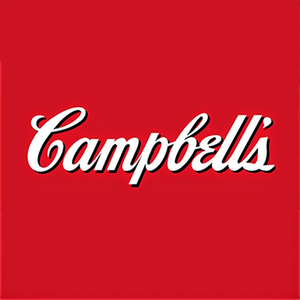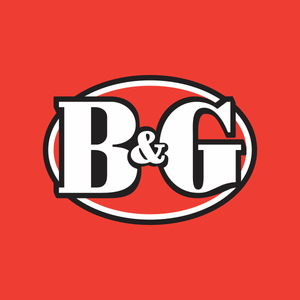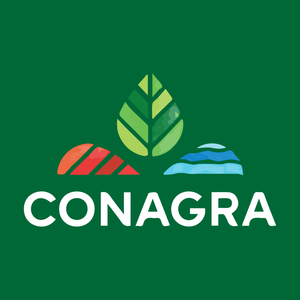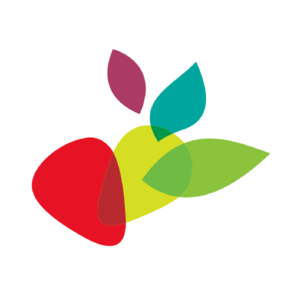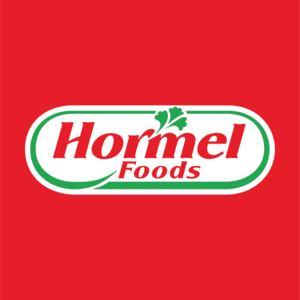
Hormel Foods (HRL)
Hormel Foods is up against the odds. Not only are its sales cratering but also its low returns on capital suggest it struggles to generate profits.― StockStory Analyst Team
1. News
2. Summary
Why We Think Hormel Foods Will Underperform
Best known for its SPAM brand, Hormel (NYSE:HRL) is a packaged foods company with products that span meat, poultry, shelf-stable foods, and spreads.
- Products fail to spark excitement with consumers, as seen in its flat sales over the last three years
- Gross margin of 16.4% is below its competitors, leaving less money to invest in areas like marketing and production facilities
- Performance over the past three years shows each sale was less profitable, as its earnings per share fell by 9.2% annually


Hormel Foods doesn’t check our boxes. We’d rather invest in businesses with stronger moats.
Why There Are Better Opportunities Than Hormel Foods
High Quality
Investable
Underperform
Why There Are Better Opportunities Than Hormel Foods
At $24.30 per share, Hormel Foods trades at 16.5x forward P/E. This multiple rich for the business quality. Not a great combination.
Paying a premium for high-quality companies with strong long-term earnings potential is preferable to owning challenged businesses with questionable prospects. That helps the prudent investor sleep well at night.
3. Hormel Foods (HRL) Research Report: Q3 CY2025 Update
Packaged foods company Hormel (NYSE:HRL) missed Wall Street’s revenue expectations in Q3 CY2025 as sales only rose 1.5% year on year to $3.19 billion. On the other hand, the company’s outlook for the full year was close to analysts’ estimates with revenue guided to $12.35 billion at the midpoint. Its non-GAAP profit of $0.32 per share was 6% above analysts’ consensus estimates.
Hormel Foods (HRL) Q3 CY2025 Highlights:
- Revenue: $3.19 billion vs analyst estimates of $3.25 billion (1.5% year-on-year growth, 2% miss)
- Adjusted EPS: $0.32 vs analyst estimates of $0.30 (6% beat)
- Adjusted EPS guidance for the upcoming financial year 2026 is $1.47 at the midpoint, beating analyst estimates by 2.1%
- Operating Margin: 0.1%, down from 9.4% in the same quarter last year
- Free Cash Flow Margin: 7.3%, down from 10.4% in the same quarter last year
- Sales Volumes fell 1.8% year on year (-4.1% in the same quarter last year)
- Market Capitalization: $12.8 billion
Company Overview
Best known for its SPAM brand, Hormel (NYSE:HRL) is a packaged foods company with products that span meat, poultry, shelf-stable foods, and spreads.
Established in 1891 by George A. Hormel, the company started as a meatpacking operation. Throughout its history, Hormel has grown its business and expanded its portfolio through organic development as well as through mergers and acquisitions. The 1936 acquisition of SPAM was transformative, as was the 2013 deal to bring Skippy peanut butter into the portfolio.
In addition to its namesake brand, SPAM, and Skippy, the company also boasts the Planters (nuts), Applegate Farms (meats), Jennie-O (meats), and Justin’s (spreads and snacks) brands. Hormel caters to low to middle-income households seeking convenience through trusted brands. The heads or caretakers of these households are usually busy and don’t have the time to cook meals or prepare snacks from scratch. The company’s products add convenience to everyday life, and they are often brands that customers have been eating since childhood.
Hormel products enjoy wide distribution. Supermarkets and grocery stores are the most common sellers of the company’s products, but consumers can also find brands such as SPAM and Skippy in mass merchandisers and discount retailers that carry food.
4. Shelf-Stable Food
As America industrialized and moved away from an agricultural economy, people faced more demands on their time. Packaged foods emerged as a solution offering convenience to the evolving American family, whether it be canned goods or snacks. Today, Americans seek brands that are high in quality, reliable, and reasonably priced. Furthermore, there's a growing emphasis on health-conscious and sustainable food options. Packaged food stocks are considered resilient investments. People always need to eat, so these companies can enjoy consistent demand as long as they stay on top of changing consumer preferences. The industry spans from multinational corporations to smaller specialized firms and is subject to food safety and labeling regulations.
Competitors in packaged food with a focus on meat include Kraft Heinz (NASDAQ:KHC), Tyson (NYSE:TSN), and Pilgrim’s Pride (NASDAQ:PPC).
5. Revenue Growth
Examining a company’s long-term performance can provide clues about its quality. Even a bad business can shine for one or two quarters, but a top-tier one grows for years.
With $12.11 billion in revenue over the past 12 months, Hormel Foods is one of the larger consumer staples companies and benefits from a well-known brand that influences purchasing decisions. However, its scale is a double-edged sword because it’s harder to find incremental growth when your existing brands have penetrated most of the market. For Hormel Foods to boost its sales, it likely needs to adjust its prices, launch new offerings, or lean into foreign markets.
As you can see below, Hormel Foods struggled to increase demand as its $12.11 billion of sales for the trailing 12 months was close to its revenue three years ago. This is mainly because consumers bought less of its products - we’ll explore what this means in the "Volume Growth" section.
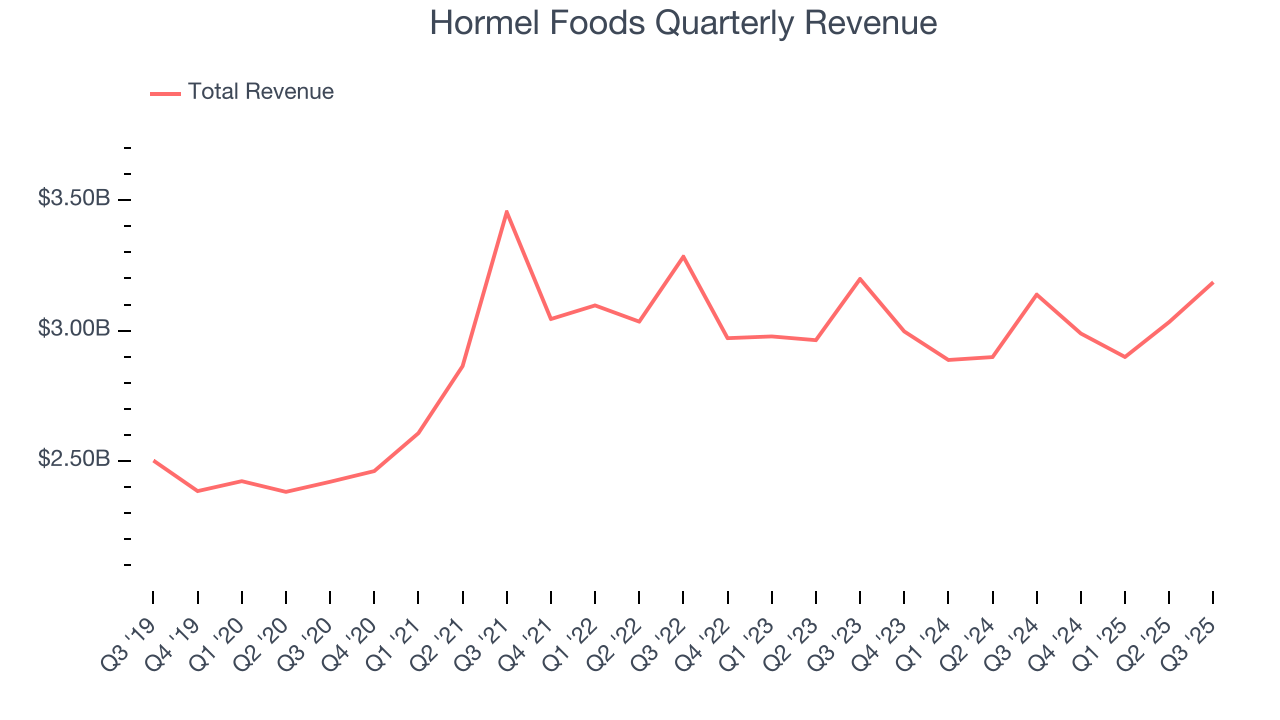
This quarter, Hormel Foods’s revenue grew by 1.5% year on year to $3.19 billion, falling short of Wall Street’s estimates.
Looking ahead, sell-side analysts expect revenue to grow 3.2% over the next 12 months. Although this projection suggests its newer products will spur better top-line performance, it is still below average for the sector.
6. Volume Growth
Revenue growth can be broken down into changes in price and volume (the number of units sold). While both are important, volume is the lifeblood of a successful staples business as there’s a ceiling to what consumers will pay for everyday goods; they can always trade down to non-branded products if the branded versions are too expensive.
Hormel Foods’s average quarterly sales volumes have shrunk by 2.5% over the last two years. This decrease isn’t ideal because the quantity demanded for consumer staples products is typically stable. 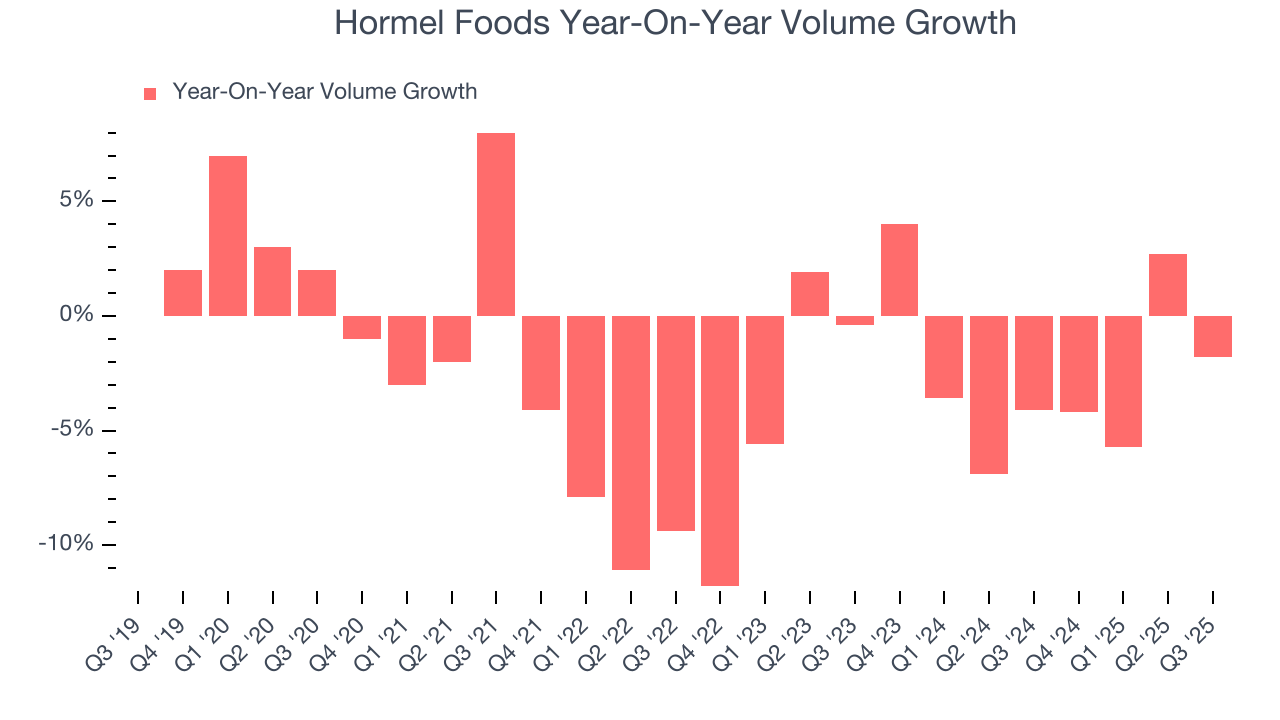
In Hormel Foods’s Q3 2025, sales volumes dropped 1.8% year on year. This result represents a further deceleration from its historical levels, showing the business is struggling to move its products.
7. Gross Margin & Pricing Power
All else equal, we prefer higher gross margins because they usually indicate that a company sells more differentiated products, has a stronger brand, and commands pricing power.
Hormel Foods has bad unit economics for a consumer staples company, signaling it operates in a competitive market and lacks pricing power because its products can be substituted. As you can see below, it averaged a 16.3% gross margin over the last two years. Said differently, for every $100 in revenue, a chunky $83.67 went towards paying for raw materials, production of goods, transportation, and distribution. 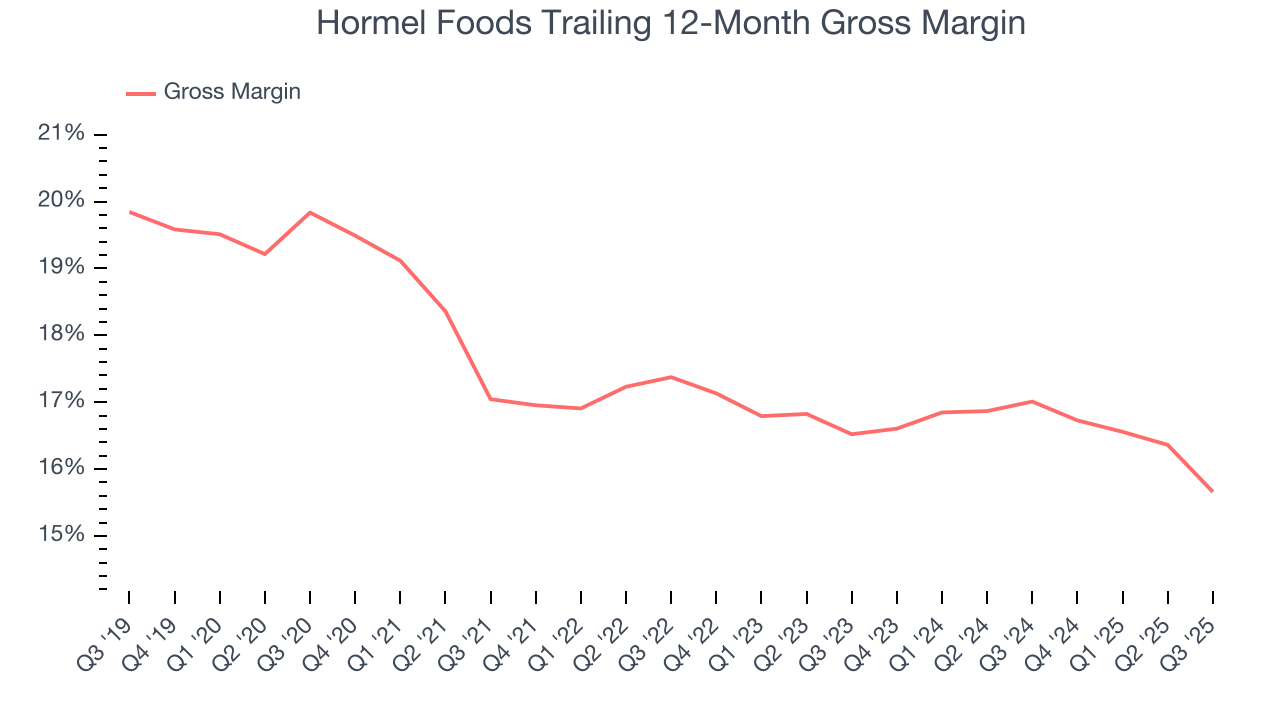
In Q3, Hormel Foods produced a 14% gross profit margin, marking a 2.7 percentage point decrease from 16.6% in the same quarter last year. Hormel Foods’s full-year margin has also been trending down over the past 12 months, decreasing by 1.4 percentage points. If this move continues, it could suggest a more competitive environment with some pressure to lower prices and higher input costs (such as raw materials and manufacturing expenses).
8. Operating Margin
Hormel Foods was profitable over the last two years but held back by its large cost base. Its average operating margin of 7.4% was weak for a consumer staples business. This result isn’t too surprising given its low gross margin as a starting point.
Analyzing the trend in its profitability, Hormel Foods’s operating margin decreased by 3 percentage points over the last year. Hormel Foods’s performance was poor no matter how you look at it - it shows that costs were rising and it couldn’t pass them onto its customers.
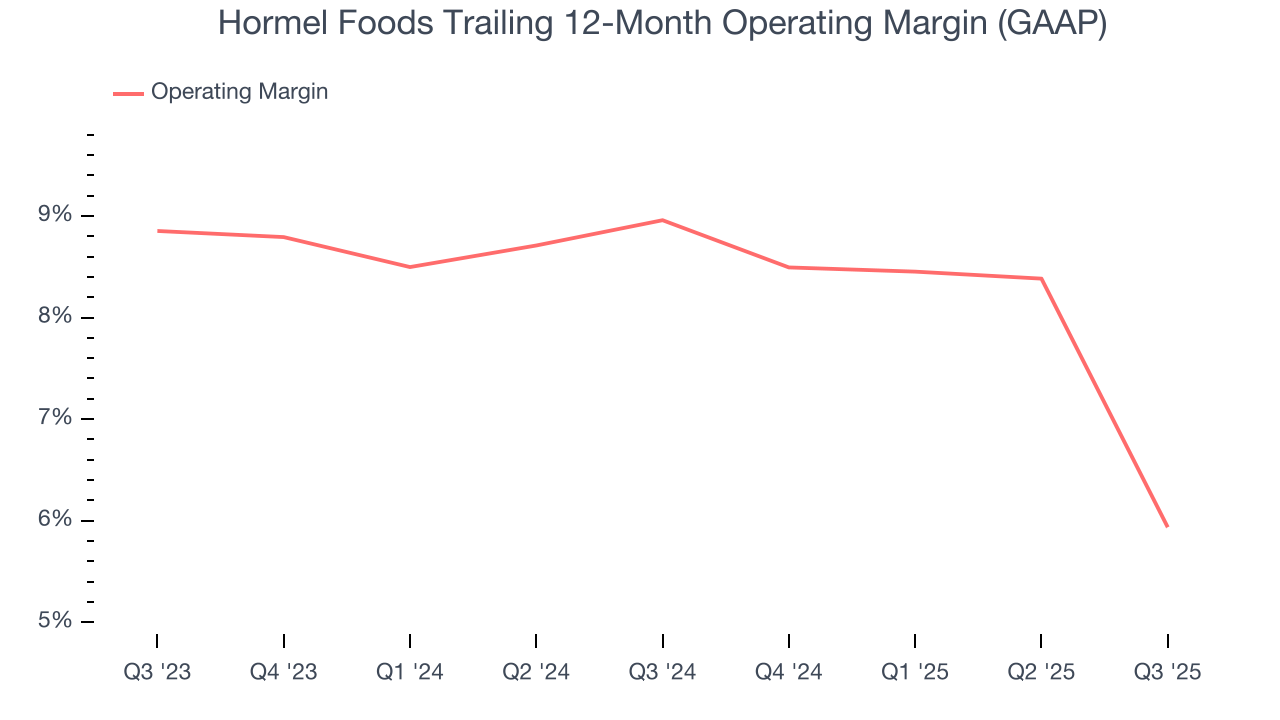
This quarter, Hormel Foods’s breakeven margin was down 9.3 percentage points year on year. Since Hormel Foods’s operating margin decreased more than its gross margin, we can assume it was less efficient because expenses such as marketing, and administrative overhead increased.
9. Earnings Per Share
Revenue trends explain a company’s historical growth, but the change in earnings per share (EPS) points to the profitability of that growth – for example, a company could inflate its sales through excessive spending on advertising and promotions.
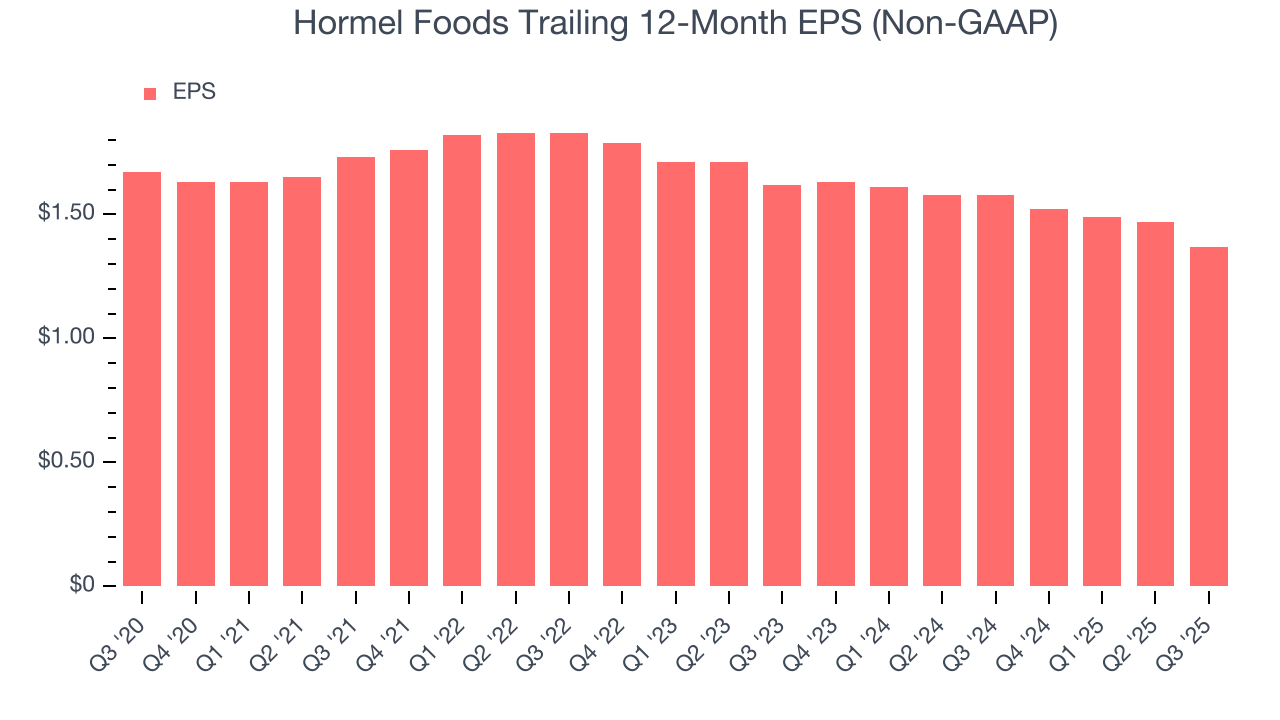
In Q3, Hormel Foods reported adjusted EPS of $0.32, down from $0.42 in the same quarter last year. Despite falling year on year, this print beat analysts’ estimates by 6%. Over the next 12 months, Wall Street expects Hormel Foods’s full-year EPS of $1.37 to grow 3.2%.
10. Cash Is King
Although earnings are undoubtedly valuable for assessing company performance, we believe cash is king because you can’t use accounting profits to pay the bills.
Hormel Foods has shown decent cash profitability, giving it some flexibility to reinvest or return capital to investors. The company’s free cash flow margin averaged 6.4% over the last two years, slightly better than the broader consumer staples sector.
Taking a step back, we can see that Hormel Foods’s margin dropped by 4.1 percentage points over the last year. If its declines continue, it could signal increasing investment needs and capital intensity.
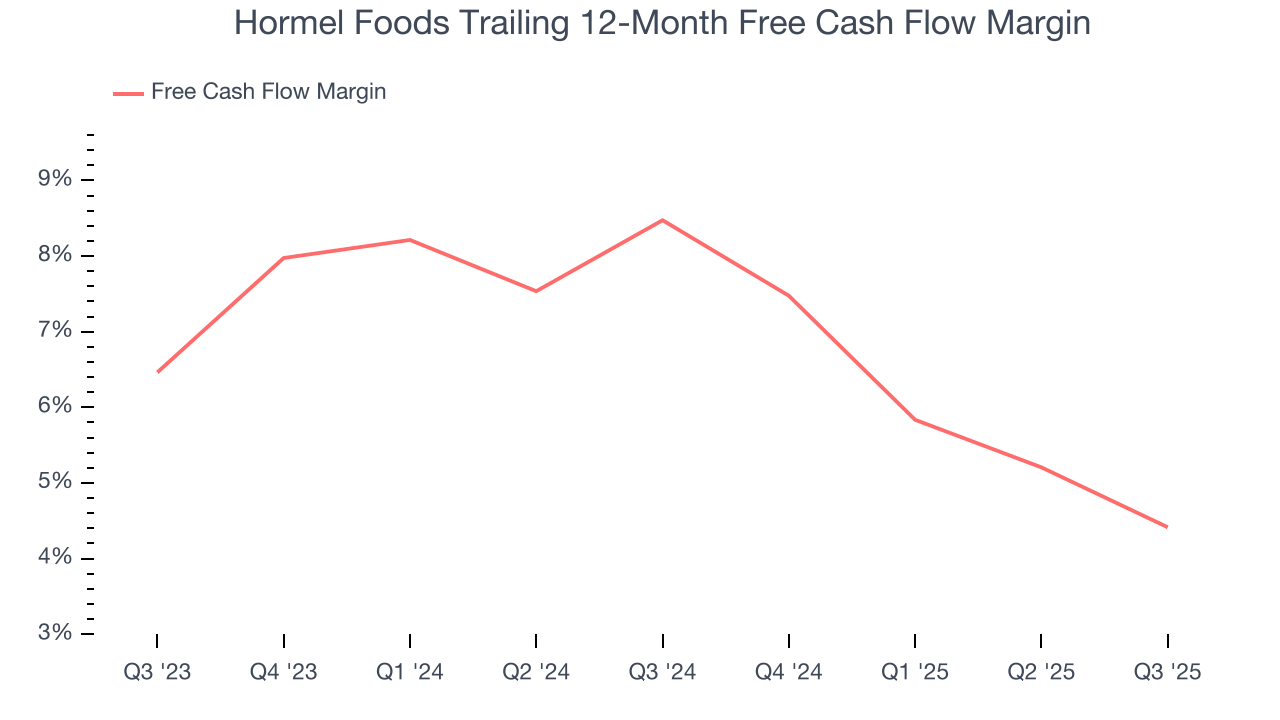
Hormel Foods’s free cash flow clocked in at $231.5 million in Q3, equivalent to a 7.3% margin. The company’s cash profitability regressed as it was 3.1 percentage points lower than in the same quarter last year, suggesting its historical struggles have dragged on.
11. Return on Invested Capital (ROIC)
EPS and free cash flow tell us whether a company was profitable while growing its revenue. But was it capital-efficient? Enter ROIC, a metric showing how much operating profit a company generates relative to the money it has raised (debt and equity).
Hormel Foods historically did a mediocre job investing in profitable growth initiatives. Its five-year average ROIC was 8.7%, somewhat low compared to the best consumer staples companies that consistently pump out 20%+.
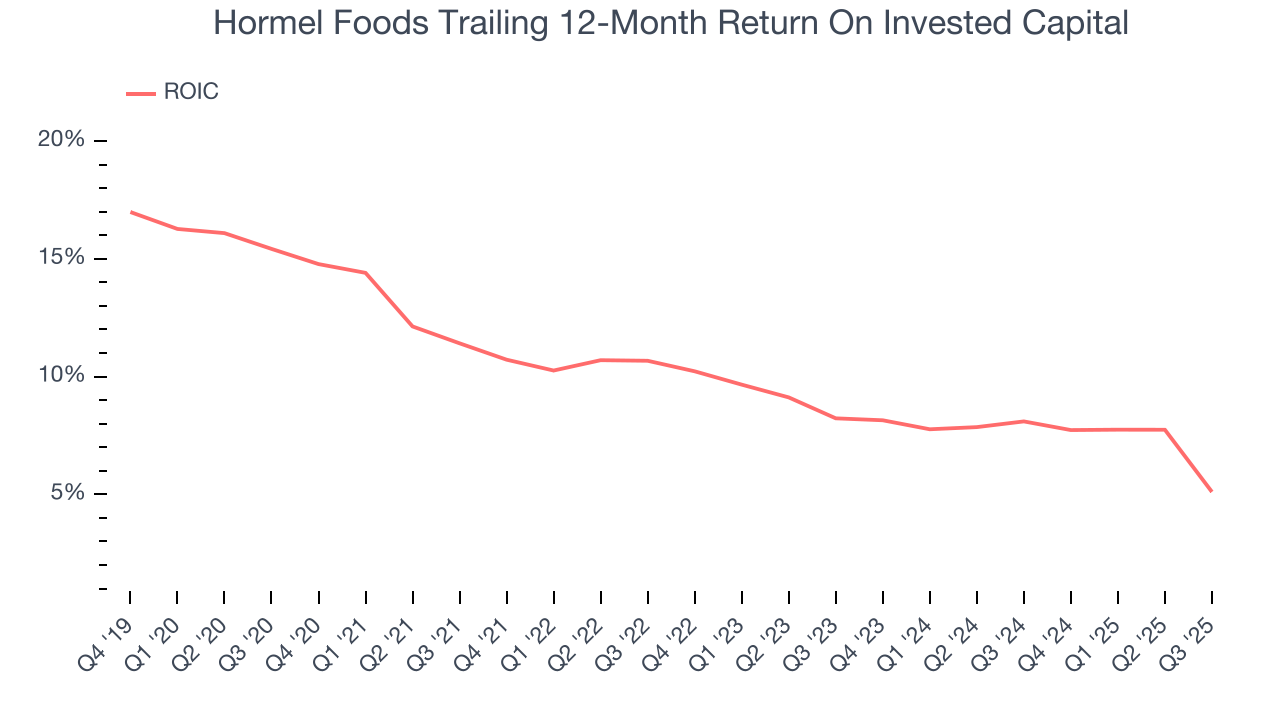
12. Balance Sheet Assessment
Hormel Foods reported $703.6 million of cash and $2.86 billion of debt on its balance sheet in the most recent quarter. As investors in high-quality companies, we primarily focus on two things: 1) that a company’s debt level isn’t too high and 2) that its interest payments are not excessively burdening the business.
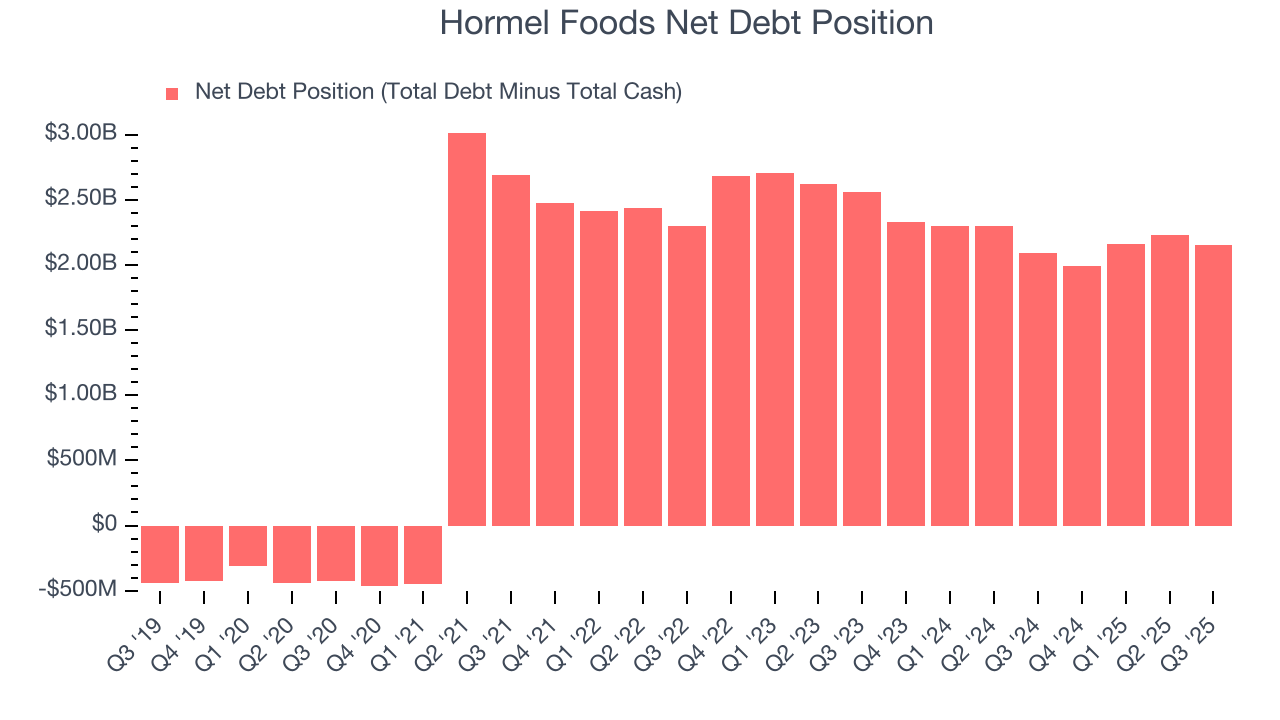
With $1.04 billion of EBITDA over the last 12 months, we view Hormel Foods’s 2.1× net-debt-to-EBITDA ratio as safe. We also see its $17.39 million of annual interest expenses as appropriate. The company’s profits give it plenty of breathing room, allowing it to continue investing in growth initiatives.
13. Key Takeaways from Hormel Foods’s Q3 Results
It was encouraging to see Hormel Foods’s full-year EPS guidance beat analysts’ expectations. We were also glad its EPS outperformed Wall Street’s estimates. On the other hand, its revenue fell short of Wall Street’s estimates. Overall, this quarter was mixed. Still, the stock traded up 3.8% to $24.31 immediately following the results.
14. Is Now The Time To Buy Hormel Foods?
Updated: December 24, 2025 at 9:52 PM EST
The latest quarterly earnings matters, sure, but we actually think longer-term fundamentals and valuation matter more. Investors should consider all these pieces before deciding whether or not to invest in Hormel Foods.
Hormel Foods doesn’t pass our quality test. To begin with, its revenue has declined over the last three years. And while its favorable brand awareness gives it meaningful influence over consumers’ dining decisions, the downside is its gross margins make it more challenging to reach positive operating profits compared to other consumer staples businesses. On top of that, its declining EPS over the last three years makes it a less attractive asset to the public markets.
Hormel Foods’s P/E ratio based on the next 12 months is 16.5x. This multiple tells us a lot of good news is priced in - we think other companies feature superior fundamentals at the moment.
Wall Street analysts have a consensus one-year price target of $27.25 on the company (compared to the current share price of $24.30).



